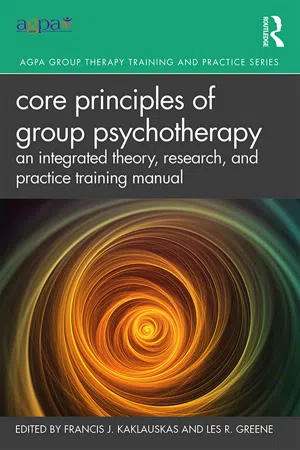
Core Principles of Group Psychotherapy
An Integrated Theory, Research, and Practice Training Manual
- 210 pages
- English
- ePUB (mobile friendly)
- Available on iOS & Android
Core Principles of Group Psychotherapy
An Integrated Theory, Research, and Practice Training Manual
About This Book
Core Principles of Group Psychotherapy is designed as the primary curriculum for the Principles of Group Psychotherapy course in partial fulfilment of the Certified Group Psychotherapist credential awarded by the International Board for Certification of Group Psychotherapists. The text is divided into five modules: foundations, structure and dynamics, formation and development, leadership tasks and skills, and ethics, neuroscience, and personal style.
The book is part of the AGPA Group Therapy Training and Practice series. This series aims to produce the highest quality publications to aid the practitioner and student in updating and improving their knowledge, professional competence, and skills with current and new developments in methods, practice, theory, and research, in the group psychotherapy field.
In addition to helping group psychotherapists bolster their skills so as to ensure the availability of quality mental health services, this guide is an essential resource for students and clinicians interested in learning more about group psychotherapy, as a text in academic courses, or as part of a practicum or internship training curriculum.
Frequently asked questions
Information
Module 1
Group Psychotherapy Foundations
1 History and Contemporary Developments
Pre-Therapy Group Influences
- Anthropologists recognize the practices of human group identifications, conflicts, connectedness, and collaboration from our earliest historical roots.
- Many worldwide myths highlight the underpinnings of group psychological factors on human behavior. These stories tell timeless tales of interpersonal alliances, misunderstandings, mistreatments, and all shades of human relatedness.
- Gustave Le Bon’s (1895) “The Crowd” described how one’s thinking and behaviors change in unique ways in varied social situations.
- Charles Triplett (1898) discussed how cyclists perform better when riding in a group or peloton than individually.
- Some cite Sigmund Freud’s Thursday night discussion group of psychoanalysts as the first group psychotherapy or group supervision meeting.
Joseph Pratt
- Pratt is usually considered the creator of group psychotherapy.
- First formal psychotherapy groups for people with tuberculosis started in 1905.
- Created out of necessity to see more patients simultaneously.
- Initially focused on lectures and providing medical information.
- Attendees reported most enjoying and benefitting from talking with one another, and Pratt increasingly utilized their between-member interactions in lieu of lectures.
- In 1921, the psychiatrist E.W. Lazell adopted and extended this group approach at St. Elizabeth’s Hospital in Washington, D.C. for World War I veterans suffering with psychotic symptoms.
Jacob Moreno
- Creator of psychodrama – a form of group therapy in which group members engage in spontaneous theater and roleplaying.
- Worked with the underprivileged in the parks in Vienna prior to World War I.
- Coined the term “group psychotherapy” in 1931.
- The following year (1932), the American Psychiatric Association held a conference that accepted this term and this new method of treatment.
- Valued spontaneity, creativity, and mutual sharing.
- Doubling: Someone stands behind and speaks for a member.
- Role reversal: Characters switch roles in the middle of the action.
- The Soliloquy: At the end of a scene the protagonist speaks spontaneously.
Other Early 20th Century Developments
- Trigant Burrow expanded psychoanalytic ideas into the group therapy format and first used the terms group analysis and here-and-now
- Post-Freudian theorists including Melanie Klein, Alfred Adler, and Carl Jung had increasing interest in interpersonal relationships and collectives.
- Kurt Lewin coined the term group dynamics (1947) in his innovative studies of group process and leadership roles
Samuel Slavson
- Believed self-expression and self-acceptance increase adjustment and happiness.
- Started with Activity Groups using art supplies with children and adolescents.
- Moved to Interview Group Therapy which encouraged members to talk honestly with one another.
- Group members were prompted to focus on each other’s positives and to have positive interchanges.
Mid Century Developments
S. H. Foulkes
- Prior to World War II, conducted private practice psychoanalytic groups.
- During and after the War, worked at Northfield Hospital to help with the mental health needs of soldiers and families.
- Group-as-a-whole – Group was seen as more than the sum of its parts (members, leader and setting), but also a whole unto itself.
- Each group has a unique pace, anticipation, defensiveness and work style.
- Identified group selection criteria.
- Group members benefited from having multiple transferences towards each other as opposed to just the individual therapist. He focused closely on how members responded to each other, and he asked about these choices or behaviors.
- Preferred the term “conductor” (as in an orchestra) to the term group leader, as he felt the title “leader” reflected negatively within the cultural context of the autocratic and destructive leaders of World War II.
Wilfred Bion
- Used an unstructured group approach to study group processes and encouraged members to focus on the group dynamics that unfolded.
- Basic Assumptions (see Chapter 5) interfere with the work of the group.
- Bion ultimately became disillusioned with group work as he returned to focus more on individual treatment, developing a sophisticated theory of personality and an interest in psychotic processes.
Table of contents
- Cover
- Half Title
- Series Page
- Title Page
- Copyright Page
- Dedication
- Table of Contents
- Guidelines for Students
- Guidelines for Instructors
- Acknowledgments
- Contributors
- Course Objectives
- Preface: The Joys and Challenges of Group Leadership
- Module 1: Group Psychotherapy Foundations: Historic, Contemporary, and Cultural Perspectives
- Module 2: Group Structure and Group Dynamics
- Module 3: Group Formation and Group Development
- Module 4: Group Leadership: Tasks and Skills
- Module 5: Group Psychotherapy in Action: Ethics, Neuroscience and Personal Style
- References
- Index